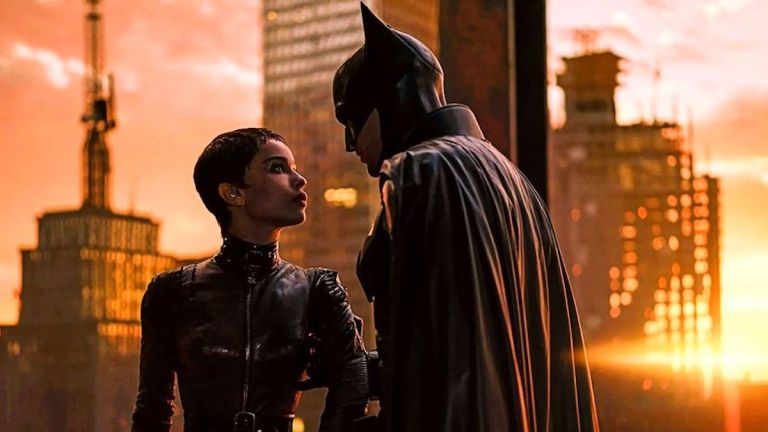The Batman: The Movie That Inspired Bruce and Catwoman’s Relationship
Exclusive: Matt Reeves and Robert Pattinson open up about some of the unexpected noir influences in The Batman.

Matt Reeves wanted to make a real neo noir with The Batman. He’s mentioned this more than once while talking about his epic reinvention of the Dark Knight, which is slated to release next month. But when he sat down to talk about the movie for the newest issue of Den of Geek magazine, Reeves revealed just how intently he studied classics of that genre, finding acute influences for everything from the degradation of Gotham City to a highly specific interpretation of Batman and Catwoman’s relationship.
It was while discussing the latter element that both Reeves and Batman actor Robert Pattinson told us about a surprising touchstone they shared for their new movie: Alan J. Pakula’s 1971 neo noir classic, Klute.
“Klute was super important,” Reeves says when talking about the early development stages of The Batman. “When I was writing, I watched a bunch of noirs… and there was something in that movie that spoke to me when I was writing about Batman and Selina Kyle. I think Jane Fonda’s performance in that movie is, to me, just incredible.”
He’s not alone. Fonda won her first Oscar for playing Bree, a call girl far more complex than what the film’s stone-faced protagonist, a small town detective named John Klute (Donald Sutherland), suspects after they cross paths on the streets of New York City.
“Klute’s such a straight arrow and he seems so naive,” says Reeves. “And I think he judges her and he assumes because of the world she’s in that she is a certain kind of person, and yet he can’t help but be drawn to her and he can’t help but be affected by her.”
That core dynamic is something Pattinson and his director talked a lot about while developing their version of the Bat and Cat relationship.
“[Bruce] is committed so hard to Batman and this kind of really binary worldview,” Pattinson says of his vigilante’s absolutism in the days before he meets a cat burglar with an affinity for strays. “There are only bad people and there’s only total innocence. There’s no one in between at all. And then Selina comes along and it throws this massive wrench in his worldview. He’s constantly trying to put her into the box of being a criminal. He’s just got this quite simplistic worldview about everything and meeting Selina is the first crack in that.”
There may even be echoes of an early scene in Klute where Sutherland’s detective says the following about New York and Bree’s lifestyle: “That’s so pathetic.”
Says Pattinson, “One of the first conversations I had with Matt about the script [was how it] has so much Klute in it. Their relationship is just so similar where he’s trying to neg her. And it becomes this weirdly sexy thing.” He adds, “There’s something about the rage that they both inspire in each other that is kind of what’s making them magnetized.”
The Klute comparison is intriguing because it suggests a superhero thriller that is pulling from a more nuanced (and arguably seedier) side of noir. In its purest form, film noir was a cinematic movement in the U.S. that began during the Second World War but really metastasized after the war. It’s viewed as a specific historical moment where American storytellers set out to make hardboiled crime sagas that—either by design or otherwise—reflected a cynicism bubbling beneath post-war optimism.
It is in this era that filmmakers created distinct tropes we know today, such as the femme fatale. Think Barbara Stanwyck standing in a towel at the top of a staircase, waiting like a spider to entrap hapless Fred MacMurray into a world of murder and sex in Double Indemnity (1944). In movies like that, there was often the wanton fatale and the virginal “good girl” who the doomed hero foolishly pushes aside. Like the new Bruce Wayne’s vision of the world, it’s all a bit binary.
Which might be why Reeves is quick to emphasize his neo in his noir influences with Zoë Kravitz’s Catwoman, particularly during the new genre’s earliest moment in the 1970s. That was the time period when the term “film noir” was retroactively applied to the past, and a new generation of filmmakers began turning the past’s trappings into a neo noir genre that both commented on and deconstructed previous tropes. This is when Klute and another touchstone for Reeves, Roman Polanski’s Chinatown (1974), challenged the idea of tidy punishments for irredeemable temptresses. Bree seduces Klute, yes, but also causes him to see the world as it really is by providing a counterpoint that cannot be quantified as “fatale” or the “courtesan with a heart of gold.”
“[The dynamic is] sort of this mix of Klute with Chinatown,” says Reeves. “Because in Chinatown, I think the Evelyn Mulwray character [played by Faye Dunaway] is a classic femme fatale, but as you get deeper into the story, [Jack Nicholson] assumes that she is a certain kind of person and assumes certain things about her morally, assumes she might be connected with this murder. But as he gets deeper into it, he understands the larger story and starts to realize that her story’s quite tragic and that he’s completely misjudged her.”
Pattinson’s Bruce might be headed to a similar miscalculation when he butts heads with Selina. Hopefully, they don’t find themselves in Chinatown at the end though.
The Batman opens only in theaters on March 4. You can read more exclusive details about the film here.
